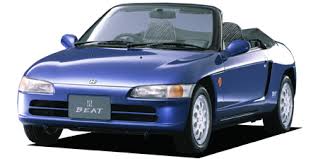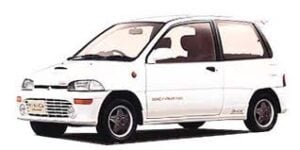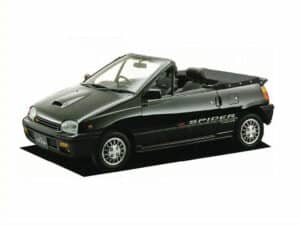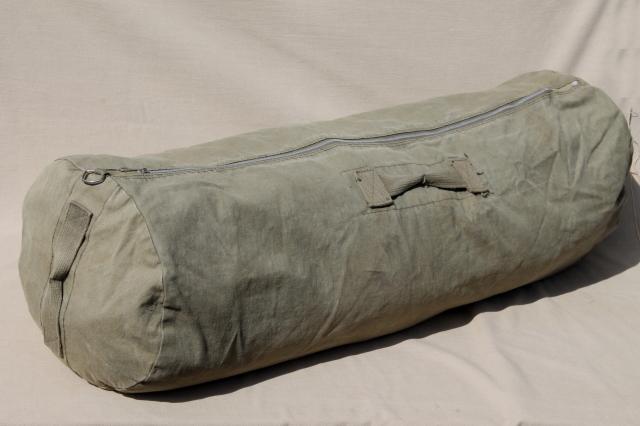A wide range of models are available
Popular Turbo Kei models include the Suzuki Alto Works, Honda Beat, Suzuki Cappuccino, Diahatsu Mira TR-XX, Mitsubishi Dangan ZZ, and the Diahatsu Leeza Spider. All models offer high-quality Japanese design and supercar-esque performance.
Please see our comparison tables for more on the specific details of each of these six models.
Mazda Autozam AZ-1
Gullwing goodness and mid-ship excitement! This little go cart sports a 660cc turbo charged F6A engine that puts out over 65 horsepower. The F6A engine is borrowed from Suzuki kei rockets like the Alto works RS/R so parts are plentiful. The world’s smallest super car is waiting for you at the Japanese auto auctions today!


Suzuki Alto Works RS/R
This lightweight, high-performance kei car combines the advantages of all-wheel-drive with a turbocharged, intercooled DOHC engine and 5-speed manual gearbox. The 8,500 redline on the tachometer is your hint that horsepower extends beyond the official 64 hp limit. Needless to say, the Alto Works RS/R is fun to drive and extremely practical in snowy weather.


The Honda Beat
The Beat’s naturally aspirated, mid-ship 656cc E07A engine with 3 inline cylinders, 12 valves and a single overhead camshaft features an 8,500 redline, 10:1 compression ratio and drive-by-wire MTREC with one throttle valve per cylinder for smoother intake, sharper throttle response and more linear power delivery. The engine revs high like a motorcycle’s with an exciting 3-cylinder rumble that combines with the low riding height and wind flowing through your hair to make driving feel fast and exciting at 84mph. The adrenaline rush is real!


Suzuki Cappuccino
Suzuki released this beautiful 2-door roadster with the promise of “fulfilling one’s dream of owning a stylish and very affordable 2 seater sportscar.” The turbocharged DOHC engine is mounted behind the front axle to achieve an impressive 50/50 weight distribution that contributes to great handling. The Cappuccino has millions of fans and there’s even a Suzuki Cappuccino racing league.


Daihatsu Mira L200 TR-XX
The top-end Mira L200 is powered by a 3-cylinder, 12-valve engine that is not only turbocharged, but electronically fuel-injected to provide both quick response and fuel efficiency. The engine is mated with a 5-speed manual transmission. Another version of the Mira in 1990 (the L220) was the only kei car to ever feature mechanical four-wheel steering.


Mitsubishi Minica Dangan ZZ-4
Small in dimensions but big on innovation, the sporty Minica Dangan ZZ-4 was the world’s first production vehicle with 5 valves per cylinder. It also features an intercooled turbocharger, double overhead camshafts, full engine management, 9000 rpm redline and 5-speed manual transmission for truly fun performance. Many enthusiasts consider it their favorite kei car.


The Daihatsu Leeza Spider
The Leeza was a largely unremarkable hatchback built from 1986 to 1993, but it had a convertible version called the Spider, and that injected it with a dash of careless cool. The 730kg droptop had a 660cc engine producing a neat 64 horsepower, and it is a great car to whip around. The cabrio top could be peeled in parts, depending how much open air you needed and it is packed with quirky amenities like under front seat storage.


But What’s the Best Japanese Kei Sports Car?
Looking at these models of Japanese Kei sports cars that we’ve got listed on this page (and there are more than these models to be found here in Japan), the question now is: “What is the best Kei sports car to import from Japan if you are going to do a direct self import?”
Direct import from Japan is the best way to go with these vehicles because that way you have access to the good selection available at both the Japanese used car auctions and at the Japanese used car dealers. (Here at Japan Car Direct, we source good units at good prices from both the auctions and the dealers.)
Anyone who has a Kei sports car now in the USA, the UK, Canada, or Australia has likely gone the self import route, knew what he wanted, and is super happy with his Kei car and will never sell it. I was like that with my Kei sports car, a Mitshibishi Minica Dangan (Bullet) ZZ;

I would never have sold that car to anyone, no matter how much money was offered. Getting toward 280,000km (over 170,000 miles), I had to retire the car when the engine was finally well and truly worn out. I’m sure it will be the same with my next Kei sports car. I’m thinking of buying a Subaru Vivio RX-R with the supercharged, intercooled straight four.

I’ve driven a number of them, tuned and stock, and, yep, that’s my next Kei sports car target. A clean, fresh RX-R like this one here that we recently exported to the USA is what I want now.
That’s what’s best for me, but what about what’s best for you in buying your own Kei sports machine? How do you decide “best?”
Be Objective and Subjective in your Choice
Truly, it isn’t easy. It’s easier to decide what to avoid when it comes to buying a used car from Japan, or buying a used car from the dealer down on Main Street USA, for that matter. You need to look at a number of factors, some objective and very important issues must be kept in your mind, and some subjective, but no less important points, cannot be ignored, either.
On the objective side, I would say that parts availability is key. Fun, cheap, simple, reliable cars are not being built much these days, but there are some wickedly good exceptions to this, like the new Suzuki Alto Works.

The best cars in the Kei sports category are mostly from the Nineties (think Suzuki Alto Works, and Cappuccino, Subaru Vivio RX-R, Daihatsu Mira TR-XX) and the early 2000s (Alto Works again, and Daihatsu Mira Gino). They are not “old” (I’m in a 1995 Japanese Kei car at the moment, and he’s very solid), but they are not brand spanking new, either, so parts are key. That being the case, I have to warn you off going for the car that I loved so much, the Mitsubishi Dangan. Parts are becoming difficult for these cars since they were so rare to begin with and the last ones (the last one? mine?) were made in January of 1993. BUT: even today, if you can find a low mileage example, consider it.
With parts in mind, if you’re looking at Pre November 1998 Kei sports cars (we talk about the whole Pre/Post 1998 thing here on our blog in “Japanese Kei Sports Cars, Part 2”), the best ones to go for from a parts perspective are the Suzuki Alto Works and the Subaru Vivio RX-R and the Daihatsu Mira TR-XX Avanzato, in that order. I’ve written about these lovely cars in the same post here.
With post Nov. 1998, the best Kei sports car that I have driven is, without a doubt, the Daihatsu Mira Gino. There is no problem with sourcing parts for these cars. To see my driving review of the Gino, have a look on our blog here.
The Suzuki Lapin SS and the Suzuki Kei Works are also easy to get parts for.
Looking at what I call the Pre Nov. 98 Exotics, like the Suzuki Cappuccino and the Honda Beat (on our blog here),
because these cars are still very present on the roads in Japan, parts are not an issue. The Cappuccino, especially, benefits from the fact that the engines used in it, the F6A and the K6A, were also used in the Alto Works, the Jimny, and other Suzuki vehicles and were made in very large numbers.
Next on the objective side, is the question of practicality. Clearly the hatchback type sports Kei cars that seat four people and have good luggage room are going to be a lot more practical than the mid-engine Honda Beat with two seats and a little compartment at the rear behind the engine where your wife or girlfriend can store her purse; that is, if she’s modest about purses and knows the difference between a purse

and a duffle bag.

(I went out with this girl once, she was a very stylish dresser and a total babe, but she always carried these huge, dumpy, sacky purses. No Honda Beat for her….But that’s not why we broke up, by the way.)
On the subjective side, there are things to consider like “looks.” For me, if I were to buy an Alto Works here in Japan now, I’d go for the 1990 to 1994 models. I just like the face. The later ones are a bit better as sports cars, actually, but…..well, I just like the face of the earlier ones. Check out the full on face shot of the black Alto Works we’ve got in this post here.
Cool look, or what? O.K……Subjective, or what?
In this area also consider the super charger vs turbo charger question, which we look at here on our blog in the same post. It’s kind of a subjective issue because some guys want the low end grunt of the super charger, even if it comes at the expense of a bit of top end power (I’m in this group); other sports car drivers want that high ultimate boost that the turbo is best at. And even among the turbo Kei sports cars made by Suzuki there are differences in power delivery and feel: The SOHC F6A with the 2-valve head gives a bit better low end push than the DOHC version of the same engine with the 4-valve head. The later K6A kind of strikes a balance between these two versions of the F6A. All these engines are great in a Japanese Kei sports car, however, whether they are in the Alto Works, the Cappuccino, or in the Mazda Autozam AZ-1.
So to help you decide what is the best Kei sports car for you to import from Japan, have a look at our blog posts on Japanese Kei Sports Cars which kick off with Part 1 (of 4) here.




